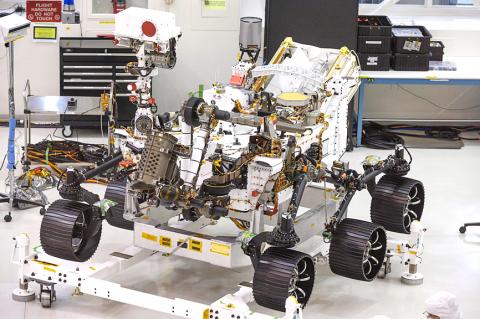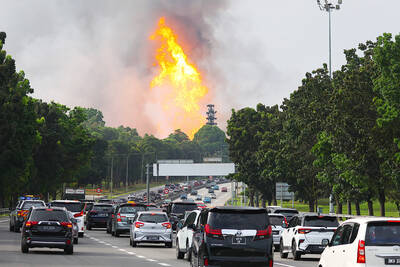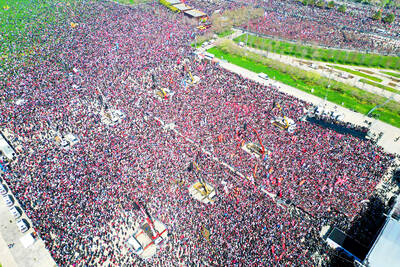A NASA robotic rover is nearing completion ahead of a journey next year to search for evidence of past life on Mars and lay the groundwork for the space agency’s mission to send humans into deep space.
The US space agency on Friday showed off its Mars 2020 rover, whose official name is to be chosen early next year.
NASA would in February ship the rover to Florida’s John F. Kennedy Space Center, where its three sections are to be fully assembled. A July launch would send the rover to a dry lake bed on Mars that is bigger than the island of Manhattan.

Photo: AFP
The six-wheeled, car-sized rover is to scour the base of Mars’ Jezero Crater, a 250m-deep crater thought to have been a lake the size of Lake Tahoe, once the craft lands in February 2021. The crater is believed to have an abundance of pristine sediments about 3.5 billion years old that scientists hope will hold fossils of Martian life.
“The trick, though, is that we’re looking for trace levels of chemicals from billions of years ago on Mars,” deputy project manager Matt Wallace told reporters.
The rover is to collect up to 30 soil samples to be picked up and returned to Earth by a future spacecraft planned by NASA.
“Once we have a sufficient set, we’ll put them down on the ground and another mission, which we hope to launch in 2026, will come, land on the surface, collect those samples and put them into a rocket, basically,” Wallace said.
Humans have never before returned sediment samples from Mars.
The findings of the rover’s research would be crucial to future human missions to the red planet, including the ability to make oxygen on the surface of Mars, Wallace said.
The rover is to carry equipment that can turn carbon dioxide, which is pervasive on Mars, into oxygen for breathing and as a propellant.
If successful, Mars 2020 would mark NASA’s fifth Martian rover to carry out a soft landing, having learned crucial lessons from the most recent rover, Curiosity, that landed on the planet’s surface in 2012 and continues to traverse a Martian plain southeast of the Jezero Crater.

A fire caused by a burst gas pipe yesterday spread to several homes and sent a fireball soaring into the sky outside Malaysia’s largest city, injuring more than 100 people. The towering inferno near a gas station in Putra Heights outside Kuala Lumpur was visible for kilometers and lasted for several hours. It happened during a public holiday as Muslims, who are the majority in Malaysia, celebrate the second day of Eid al-Fitr. National oil company Petronas said the fire started at one of its gas pipelines at 8:10am and the affected pipeline was later isolated. Disaster management officials said shutting the

US Vice President J.D. Vance on Friday accused Denmark of not having done enough to protect Greenland, when he visited the strategically placed and resource-rich Danish territory coveted by US President Donald Trump. Vance made his comment during a trip to the Pituffik Space Base in northwestern Greenland, a visit viewed by Copenhagen and Nuuk as a provocation. “Our message to Denmark is very simple: You have not done a good job by the people of Greenland,” Vance told a news conference. “You have under-invested in the people of Greenland, and you have under-invested in the security architecture of this

Japan unveiled a plan on Thursday to evacuate around 120,000 residents and tourists from its southern islets near Taiwan within six days in the event of an “emergency”. The plan was put together as “the security situation surrounding our nation grows severe” and with an “emergency” in mind, the government’s crisis management office said. Exactly what that emergency might be was left unspecified in the plan but it envisages the evacuation of around 120,000 people in five Japanese islets close to Taiwan. China claims Taiwan as part of its territory and has stepped up military pressure in recent years, including

UNREST: The authorities in Turkey arrested 13 Turkish journalists in five days, deported a BBC correspondent and on Thursday arrested a reporter from Sweden Waving flags and chanting slogans, many hundreds of thousands of anti-government demonstrators on Saturday rallied in Istanbul, Turkey, in defence of democracy after the arrest of Istanbul Mayor Ekrem Imamoglu which sparked Turkey’s worst street unrest in more than a decade. Under a cloudless blue sky, vast crowds gathered in Maltepe on the Asian side of Turkey’s biggest city on the eve of the Eid al-Fitr celebration which started yesterday, marking the end of Ramadan. Ozgur Ozel, chairman of the main opposition Republican People’s Party (CHP), which organized the rally, said there were 2.2 million people in the crowd, but